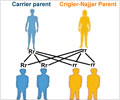Transplantation of liver is often used for cancer that occurs within the liver.

This is a tumor we have always struggled with, says Christopher Sonnenday, M.D., M.H.S., assistant professor of surgery at the U-M Medical School. Sonnenday, a transplant surgeon, is part of the Multidisciplinary Liver Tumor Clinic at the U-M Comprehensive Cancer Center.
Historically, transplant has not been thought to be a great treatment for cancer. What we’ve learned in recent years is that if you select patients very carefully and find the right patients, those patients can potentially be helped by transplant, Sonnenday says. The procedure is best for patients with bile duct cancer that is not surgically treatable and has not spread to other organs.
Patients are first treated with combined chemotherapy and radiation and given a series of tests to prove the cancer has not spread.Because these patients don’t have chronic liver disease like a typical transplant candidate, the United Network for Organ Sharing automatically gives them extra points on the liver allocation system so that they have a fair spot on the list, relative to the urgency of their disease. Typically, a liver is available within three to six months. During surgery, doctors remove all of the liver and bile duct and perform the liver transplant.
Bile duct cancer patients who undergo traditional surgery have a 30 percent to 40 percent five-year survival rate. For patients who cannot have surgery, survival is only 5 percent to 10 percent.
Early data for treatment with liver transplant suggests five-year survival of 75 percent to 85 percent, which is similar to overall liver transplant survival rates.
Advertisement
Gehle was the first to undergo the procedure at U-M, after being on the transplant list for about a month. Just over a year later, he’s cancer-free.
Advertisement
Bile duct cancer statistics: About 3,000 Americans are diagnosed with cholangiocarcinoma, or bile duct cancer, each year. After five years, fewer than 20 percent are alive
Source-Newswise















